Related Research Articles

Lindsay is a community of 22,367 people on the Scugog River in the Kawartha Lakes region of south-eastern Ontario, Canada. It is approximately 43 km (27 mi) west of Peterborough. It is the seat of the City of Kawartha Lakes, and the hub for business and commerce in the region.
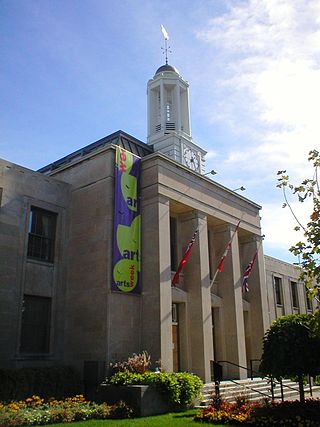
Peterborough is a city on the Otonabee River in Ontario, Canada, about 125 kilometres northeast of Toronto. According to the 2021 Census, the population of the City of Peterborough was 83,651. The population of the Peterborough Census Metropolitan Area (CMA), which includes the surrounding Townships of Selwyn, Cavan Monaghan, Otonabee-South Monaghan, and Douro-Dummer, was 128,624 in 2021. In 2021, Peterborough ranked 32nd among the country's 41 census metropolitan areas according to the CMA in Canada. The current mayor of Peterborough is Jeff Leal.
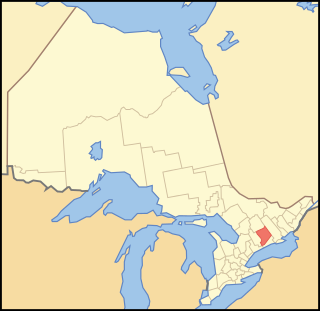
Peterborough County is located in Southern Ontario, Canada. The county seat is The City of Peterborough, which is independent of the county.

Selwyn is a township in central-eastern Ontario, Canada, located in Peterborough County. The township comprises a mix of rural areas and built up urban areas.

Cavan Monaghan is a township in Peterborough County in central-eastern Ontario, Canada, 20 kilometres (12 mi) southwest of the city of Peterborough.
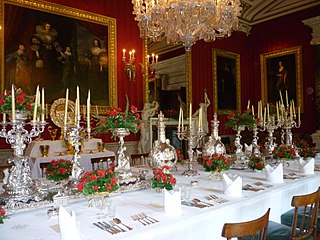
Tableware items are the dishware and utensils used for setting a table, serving food, and dining. The term includes cutlery, glassware, serving dishes, serving utensils, and other items used for practical as well as decorative purposes. The quality, nature, variety and number of objects varies according to culture, religion, number of diners, cuisine and occasion. For example, Middle Eastern, Indian or Polynesian food culture and cuisine sometimes limits tableware to serving dishes, using bread or leaves as individual plates, and not infrequently without use of cutlery. Special occasions are usually reflected in higher quality tableware.

PACE at Peterborough Collegiate, formerly Peterborough Collegiate Vocational School, is a public secondary school located in Peterborough, Ontario, Canada and is a member of the Kawartha Pine Ridge District School Board. It is one of the oldest public schools in the country and was the only public high school in the city of Peterborough until the opening of Kenner Collegiate Vocational Institute in 1952. Regular student programming ended at Peterborough Collegiate Vocational School in June 2012. The building was renamed Peterborough Collegiate and in August 2012 opened as a re-purposed facility offering alternative and continuing education (ACE).
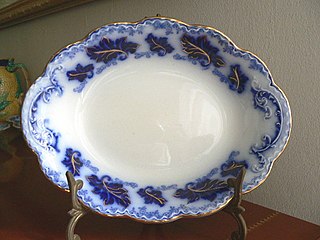
Johnson Brothers was a British tableware manufacturer and exporter that was noted for its early introduction of "semi-porcelain" tableware. It was among the most successful Staffordshire potteries which produced tableware, much of it exported to the United States, from the 1890s through to the 1960s. They were also important manufacturers of large bathroom ceramics. Some of its designs, such as "Eternal Beau", "Dawn", "Old Britain Castles" and "Historic America", achieved widespread popularity and are still collected today. The company's success was due in part to its ability to identify and follow trends that appealed to its customers in the United States, and in part to the high quality of its designs, produced by skilled artists.

Blue Ridge is a brand and range of American tableware (dishware) manufactured by Southern Potteries Incorporated from the 1930s until 1957. Well known in their day for their underglaze decoration and colorful patterns, Blue Ridge pieces are now popular items with collectors of antique dishware. The underglaze technique made the decorations more durable, and while basic patterns were reused consistently, the fact that each piece was hand-painted means that no two pieces are exactly alike.

Flourless chocolate cake is a dense cake made from an aerated chocolate custard. The first documented form of the cake was seen in Ferrara, Italy, though some forms of the cake have myths surrounding their origins. The dessert contains no gluten, which makes it acceptable for those with celiac disease, gluten-free diets, and during religious holidays in which gluten and grains are not permitted.

Bing & Grøndahl was a Danish porcelain manufacturer founded in 1853 by the sculptor Frederik Vilhelm Grøndahl and merchant brothers Meyer Hermann Bing and Jacob Herman Bing. The trademark backstamp for Bing & Grøndahl (B&G) porcelains is the three towers derived from the Coat of Arms of Copenhagen. The company's Seagull dinnerware series became known as the "National Service of Denmark" in the 1950s when it was found in one tenth of all Danish households. In 1987 the company merged with its primary competitor, the Royal Porcelain Factory under the name Royal Copenhagen.

Rörstrand porcelain was one of the most famous Swedish porcelain manufacturers, with production initially at Karlbergskanalen in Birkastan in Stockholm.

Davenport Pottery was an English earthenware and porcelain manufacturer based in Longport, Staffordshire. It was in business, owned and run by the Davenport family, between 1794 and 1887, making mostly tablewares in the main types of Staffordshire pottery.
The 2000 Peterborough municipal election was held in the city of Peterborough, Ontario, Canada on November 13, 2000, to choose the mayor and city councillors to sit on the Peterborough city council. Electors in Peterborough also voted for the city's representatives on the regional public and separate school boards.

Restaurant ware, or most commonly hotelware, is vitrified, ceramic tableware which exhibits high mechanical strength and is produced for use in hotels and restaurants. Tableware used in railway dining cars, passenger ships and airlines are also included in this category.
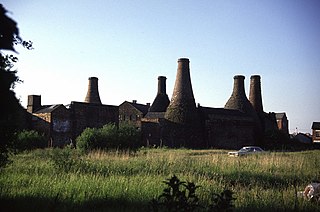
A potbank is a colloquial name for a pottery factory in North Staffordshire used to make bone china, earthenware and sanitaryware.

Ceramic art is art made from ceramic materials, including clay. It may take varied forms, including artistic pottery, including tableware, tiles, figurines and other sculpture. As one of the plastic arts, ceramic art is a visual art. While some ceramics are considered fine art, such as pottery or sculpture, most are considered to be decorative, industrial or applied art objects. Ceramic art can be created by one person or by a group, in a pottery or a ceramic factory with a group designing and manufacturing the artware.

Maryam Monsef is an Afghan Canadian politician. She served as the member of Parliament for the riding of Peterborough—Kawartha from 2015 to 2021 as a member of the Liberal Party of Canada.
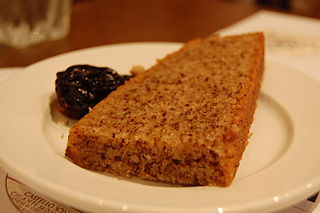
Chestnut cake is a cake prepared using chestnuts. Chestnut flour prepared from cooked, ground chestnuts is used in its preparation, along with additional typical cake ingredients. It is sometimes prepared as a chocolate cake. Chestnuts are sometimes used in a frosting or glaze atop the cake, and it may be garnished with cooked or candied chestnuts. It can be prepared as a gluten-free dish.

Little Lake is a small lake on the Otonabee River in the city of Peterborough, Ontario, Canada. The lake is in the downtown of the city and is used for fishing, swimming, boating, and for various special events. The lake lies on the water route from Lake Ontario to the Kawartha Lakes. The area around the lake was first settled by Europeans around the start of the 19th century. Steam- and water-powered saw mills were built on the lake and on the river upstream to prepare lumber for shipment overseas. Sawdust and other debris from the mills polluted the lake, killed the fish and clogged up the navigable channels. The smell was so noxious it drove residents near the lake to move. These problems were resolved by the end of the century, when the lake became a hub on the new Trent-Severn Waterway from Lake Ontario to Lake Huron. However, industries attracted by cheap hydroelectric power, such as General Electric used the lake for disposal of industrial chemicals for many years. The pollutants seems to be mostly contained in the sediment, and the lake is now considered safe for recreational use.
References
- 1 2 Culley, Joanne (14 September 2019). "Otonabee Ward: Peterborough and area artists open their doors for annual studio tour". The Peterborough Examiner. Retrieved 16 August 2021.
- 1 2 Kelly, Caitlin (9 July 2009). "After years of toil, his plate is full". Toronto Star. Retrieved 16 August 2021.
- 1 2 Anderson, Lance (15 July 2015). "PETERBIO: Bill Reddick". Peterborough This Week. Retrieved 16 August 2021.
- ↑ Harris, John (7 December 1977). "Dream becomes a reality for two Erin twp. potters" (PDF). The Acton Free Press. p. 9. Retrieved 16 August 2021.
- 1 2 Chiang, Jack (8 February 1992). "A House with a history". The Whig - Standard. p. 1.
- 1 2 3 4 "Potter Bill Reddick's creative spark". Frontenac News. October 21, 2010. Retrieved May 22, 2022.
- ↑ Head, Bruce (17 June 2020). "businessNow - June 17, 2020". kawarthaNOW. Artist Bill Reddick pivots during the pandemic to turn his famous gluten-free chocolate cake into his livelihood. Retrieved 17 August 2021.
- ↑ Tuffin, Lois (22 October 2015). "Why was MP Maryam Monsef handed a chocolate cake on election night?". Peterborough This Week. Retrieved 17 August 2021.
- ↑ "Monsef sworn in as MP". The Peterborough Examiner. 24 November 2015. Retrieved 17 August 2021.
- ↑ Cotnam, Hallie (20 June 2020). "Pandemic sparks creativity for some entrepreneurs". CBC. Retrieved 22 May 2022.
- ↑ Gotlieb, Rachel (7 October 2006). "Home plates". The Globe and Mail. p. L8.
- ↑ "Bill Reddick studio porcelain". The Soujourner. 2011. p. 21. Retrieved June 23, 2022– via Issuu.
- ↑ "Celebrity dish maker of the week". National Post. 7 March 2009. p. WP7.
- ↑ Atiknson, Nathalie; Ermter, Adriana (6 December 2003). "Last call for One of a Kind". National Post. p. TO12.
- ↑ Mackinnon, Donna Jean (4 March 2007). "Dishing up Canada". Toronto Star. p. G7.
- ↑ "Bill Reddick". Art Gallery of Peterborough. Retrieved 17 August 2021.
- ↑ Hendry, Luke (22 May 2009). "U. S. President has eaten off County potter's plates". The Intelligencer. p. C 1.